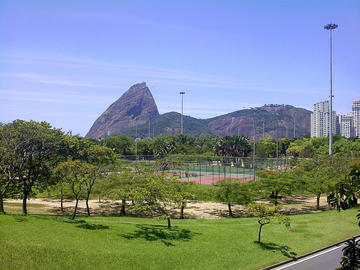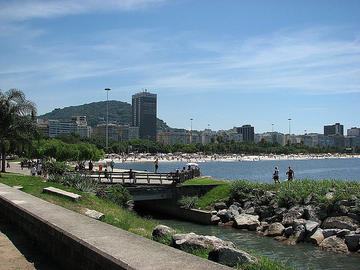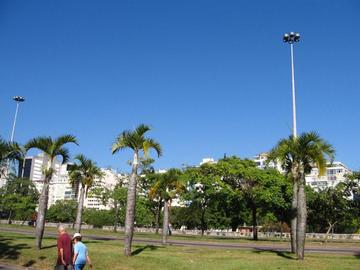Picture
More information on Flamengo Park - Rio de Janeiro

Description: Flamengo Park - Rio de Janeiro
Parque do Flamengo, also known as Aterro do Flamengo.
Flamengo Park
Parque Brigadeiro Eduardo Gomes, known as the Flamengo Park, has 1,200,000 square meters of green area on the seafront, with flowering bushes, a profusion of trees is one of the most visited and beautiful recreation areas in the city.
The idealization of the park was Lota Macedo Soares, elite family in Rio.
College but did not was a student of Candido Portinari and became an esthetician with knowledge of architecture and urbanism. Lota was also known for their curiosity and knowledge of plants.
To fill the area, the hill of San Antonio was taken down with water jets. The same dredger that opened the Panama Canal, took sand from the sea to create Botafogo Beach.
Lota got the idea to illuminate the landfill at night to allow night walks in the park. The sports facilities were her idea, which is rented all year round, including the night, when they are taken by teams from various associations.
With the endorsement of Governor Carlos Lacerda, gathered a group of distinguished friends, the landscape artist Roberto Burle Marx, the botanist Emygdio Luiz de Mello Filho and architects Affonso Eduardo Reidy, Jorge Moreira and Sérgio Bernardes.
It was a working group that met under the leadership of Lota.
The green carpet that covers this vast area has caused many disagreements between group members and also with the staff of urbanization, at the time. Lota wanted only two lanes for cars (and did) while the planning staff of the required four lanes.
From the rubble came 11,600 trees of 190 species and 4,400 native and exotic palm trees of 50 species are gems like talipot (Corypha umbraculifera) which blooms only once and dies (as witnessed by around 2003/2004).
Apart from being an urban park, it has special characteristics, such as groups of plants of the same species, the use of Brazilian plants that were not usually used in landscaping - such as the apricot-and-wood mulatto monkey - (this information is Haruyoshi Ono gives the architect who worked on the project as an intern and is now director of the Burle Marx (The Globe 11.05.2005).
The park was informally inaugurated on 12 October 1965, Children's Day, with a great popular festival conceived by Lota.
It was the birth of a major recreation areas in the city, multipurpose courts, soccer fields, playground, amphitheater, skating rinks and model airplanes. There is also a restaurant and kiosk, the Gloria Marina and the Museum of Modern Art - MAM.
The park was incorporated into the city landscape, and became a landmark as the Sugar Loaf and Corcovado, as was the dream of Lota.
Santos Dumont Airport to Botafogo Bay, the park offers a variety of attractions. An interesting itinerary, for example, can be started at the Museum of Modern Art, moving to the Monument to World War II Soldier, the Marina da Gloria, Carmen Miranda Museum, the Monument to the Estacio de Sa - founder of the city. An interesting spectacle is the changing of the guard by three armed, always on the first Sunday of each month at the Monument to World War II Soldier. On Sundays and holidays the landfill and their lanes are fully released to the public which uses it to focus on more varied forms of leisure.
http://www0.rio.rj.gov.br/riotur/pt/atracao/?CodAtr=1880
Photo by: Cyro A. SilvaMore Photos of Picture



